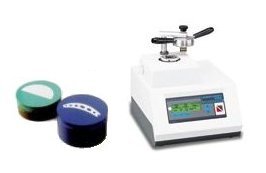
Alphabetical Index
Browse by Elements
Keyword Search
ASTM Electrolytes
Macro Etchants
Micro Etchants
Named Etchants
New Etchants
Al and Al Alloys
Cu and Cu Alloys
Fe and Fe Alloys
Ni and Ni Alloys
Carbide Etchants
Fluoride Etchants
Nitride Etchants
Other Etchants
Oxide Etchants
Phosphide Etchants
Single Crystal Etchants
Thin Film Etchants
Wafer Etchants
Help
Home
Hot Sample Mounting
Hot mounting uses a thermosetting compound, cured in a mounting press which exerts both heat and high pressure. This mounting method produces hard mounts in a short space of time. However the heating (generally in the order of 120 °C) and considerable pressure applied may be unsuitable for delicate, soft or low melting point specimens.

Techniques may be used to protect a delicate sample from the effects of pressure, such as placing the sample under a supporting structure within the moulding cavity. Such a supporting structure can protect the sample from the initial pressure applied when the mounting material is in a granular form, and most likely to inflict damage. When the mounting material becomes fluid, infiltration should occur to encapsulate the sample which will then be subject to hydrostatic pressure. Hydrostatic pressure can be applied to all but the most delicate of samples without problem. In the case of very soft or thermally sensitive materials, hot mounting is not appropriate. Conductive mounting resins are available, which are good for SEM examination, although the adhesion and hardness characteristics are not as good as those of epoxy hot set compounds. If the edges of the specimen are not of interest, then non conductive mounting materials can be used. In general, hot mounting is preferable to cold setting resins, when the sample is not affected by temperature and pressure (200º C & 50 kN). However, not all specimens can tolerate this.
Non-conductive mounts must be covered with adhesive conductive tape or coated with a conductive medium (the sample area can be masked if sputter coating, or using an evaporator. Aluminium foil or glass cover slips are useful for this purpose. Note: many adhesive metal tapes have non-conductive adhesive, so the use of carbon/silver conductive paint may be required at seams. Whilst very thin films of carbon can be tolerated on the sample, the ideal is that the sample surface should be bare.
Hot Mounting may be unacceptable, if the effect of temperature and pressure are expected to be inappropriate for the sample under investigation.
Generally, the materials employed for cold setting cannot match the hardness of materials traditionally used in Hot Mounting. This may lead to compromises in the degree of edge protection and support that the mount provides for the sample. Further, the abrasion characteristics may need to be taken into account during the preparation.
The material should be stable under vacuum. Out-gassing can be a major problem leading to high contamination rates on the sample, and even microscope parts.